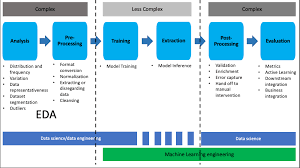Exploratory Analytics: Unveiling Insights in Data
Exploratory analytics is a crucial process in data analysis that focuses on uncovering hidden patterns, trends, and relationships within datasets. It involves a preliminary exploration of data to gain a better understanding of its characteristics before formal modelling or hypothesis testing.
Unlike traditional analytics that often have predefined questions and objectives, exploratory analytics is more open-ended and aims to discover insights that may not have been initially sought. By using visualisation tools, statistical techniques, and data mining methods, analysts can delve into the data to identify interesting observations and generate hypotheses for further investigation.
One of the key benefits of exploratory analytics is its ability to reveal unexpected findings and outliers that can lead to new discoveries or opportunities. It allows analysts to interact with the data dynamically, iteratively refining their analysis based on emerging patterns or anomalies.
Moreover, exploratory analytics plays a vital role in the early stages of the data analysis process, helping analysts understand the structure of the data, assess data quality, and identify potential variables for predictive modelling or deeper analysis. It serves as a foundation for building more complex analytical models and making informed decisions based on data-driven insights.
With the increasing volume and complexity of data generated in today’s digital age, exploratory analytics has become an essential tool for businesses seeking to extract value from their data assets. By leveraging advanced analytics techniques and visualisation tools, organisations can gain a competitive edge by uncovering hidden patterns and trends that drive strategic decision-making.
In conclusion, exploratory analytics empowers analysts to explore data in a flexible and interactive manner, enabling them to uncover valuable insights that drive innovation and business growth. By embracing this explorative approach to data analysis, organisations can unlock the full potential of their data resources and stay ahead in an increasingly data-driven world.
Uncovering Insights: The 8 Advantages of Exploratory Analytics
- Reveals hidden patterns and trends in data
- Allows for open-ended exploration of data
- Identifies unexpected findings and outliers
- Facilitates dynamic interaction with data
- Assists in understanding data structure and quality
- Provides a foundation for predictive modelling
- Enables informed decision-making based on insights
- Empowers businesses to extract value from data assets
Challenges of Exploratory Analytics: Navigating Time, Bias, and Expertise
- 1. Time-consuming process due to the exploratory nature of analysis.
- 2. May lead to biased interpretations if not conducted rigorously.
- 3. Difficulty in distinguishing between meaningful insights and random patterns.
- 4. Requires skilled analysts with expertise in data exploration techniques.
- 5. Limited ability to draw definitive conclusions without further hypothesis testing.
- 6. Potential for data overload and information fatigue when exploring large datasets.
- 7. Lack of standardised methodologies can result in inconsistent results across analyses.
Reveals hidden patterns and trends in data
Exploratory analytics excels in revealing hidden patterns and trends within data that may not be immediately apparent. By employing visualisation tools, statistical techniques, and data mining methods, analysts can uncover valuable insights that go beyond surface-level observations. This capability allows businesses to identify emerging trends, detect anomalies, and gain a deeper understanding of their data, ultimately enabling informed decision-making and strategic planning based on the uncovered patterns.
Allows for open-ended exploration of data
Exploratory analytics offers the valuable advantage of allowing for open-ended exploration of data, enabling analysts to uncover unexpected insights and patterns that may not have been initially anticipated. By adopting a flexible and interactive approach to data analysis, exploratory analytics empowers analysts to delve deep into the dataset without predefined objectives, fostering a creative and dynamic exploration process. This open-ended exploration not only leads to the discovery of hidden relationships and trends but also sparks new ideas and hypotheses for further investigation, ultimately enhancing the depth and breadth of insights derived from the data.
Identifies unexpected findings and outliers
Exploratory analytics excels in identifying unexpected findings and outliers within datasets, providing valuable insights that may go unnoticed through traditional analytical approaches. By uncovering these anomalies, analysts can gain a deeper understanding of the data and potentially discover new patterns or trends that can lead to innovative solutions or strategic opportunities. This ability to detect outliers not only enhances data quality assessment but also enables organisations to make more informed decisions based on comprehensive and nuanced insights derived from their data analysis.
Facilitates dynamic interaction with data
Exploratory analytics offers the valuable advantage of facilitating dynamic interaction with data, allowing analysts to engage with the dataset in a flexible and iterative manner. This interactive approach enables users to explore the data from various angles, adjust parameters on-the-fly, and instantly visualise the results. By actively engaging with the data in real-time, analysts can uncover hidden patterns, outliers, and trends that may not be apparent through static analysis methods. This dynamic interaction empowers analysts to gain deeper insights and make informed decisions based on a comprehensive understanding of the data landscape.
Assists in understanding data structure and quality
Exploratory analytics plays a crucial role in assisting analysts in understanding the structure and quality of data. By conducting a preliminary exploration of datasets, analysts can gain insights into how the data is organised, the relationships between variables, and any potential issues such as missing values or outliers. This deeper understanding of data structure and quality not only helps in identifying key variables for further analysis but also enables analysts to make informed decisions about data cleaning and preprocessing steps. Ultimately, this pro of exploratory analytics ensures that subsequent analyses are based on reliable and high-quality data, leading to more accurate and meaningful insights.
Provides a foundation for predictive modelling
Exploratory analytics serves as a crucial foundation for predictive modelling by enabling analysts to understand the underlying patterns and relationships within the data. By exploring and visualising the data in an open-ended manner, analysts can identify key variables, trends, and outliers that are essential for building accurate predictive models. This preliminary exploration not only helps in selecting the most relevant features for modelling but also provides insights into potential correlations that can significantly improve the predictive accuracy of the models. Ultimately, by leveraging the insights gained through exploratory analytics, organisations can develop robust predictive models that drive informed decision-making and enhance business outcomes.
Enables informed decision-making based on insights
Exploratory analytics empowers organisations to make informed decisions based on valuable insights extracted from data exploration. By uncovering hidden patterns, trends, and relationships within datasets, businesses can gain a deeper understanding of their operations, customers, and market dynamics. This enables decision-makers to identify opportunities, mitigate risks, and develop strategies that are backed by data-driven evidence. Ultimately, the ability to leverage insights obtained through exploratory analytics facilitates more informed and strategic decision-making processes that drive business growth and success.
Empowers businesses to extract value from data assets
Exploratory analytics empowers businesses to extract value from their data assets by enabling a comprehensive and in-depth exploration of their datasets. By uncovering hidden patterns, trends, and relationships within the data, businesses can gain valuable insights that drive strategic decision-making and inform future actions. This proactive approach allows organisations to maximise the potential of their data resources, identify opportunities for growth and innovation, and stay competitive in today’s data-driven business landscape.
1. Time-consuming process due to the exploratory nature of analysis.
Exploratory analytics can be a time-consuming process due to its exploratory nature, where analysts delve into data without predefined questions or objectives. The open-ended exploration of datasets requires thorough examination and iteration to uncover meaningful insights, which can extend the analysis timeline. As analysts sift through data, identify patterns, and generate hypotheses, the iterative nature of exploratory analytics demands careful attention to detail and comprehensive exploration, contributing to the overall time investment required for this analytical approach.
2. May lead to biased interpretations if not conducted rigorously.
Exploratory analytics, while a valuable tool for uncovering hidden insights in data, can also present a significant challenge if not conducted rigorously. One notable con is that it may lead to biased interpretations if proper care and attention are not given during the analysis process. Without robust methodologies and rigorous validation, analysts run the risk of drawing conclusions based on incomplete or misleading information, potentially leading to inaccurate insights and flawed decision-making. Therefore, it is essential for analysts to approach exploratory analytics with diligence and thoroughness to mitigate the risk of bias and ensure the reliability of their findings.
3. Difficulty in distinguishing between meaningful insights and random patterns.
One significant drawback of exploratory analytics is the challenge it poses in distinguishing between meaningful insights and random patterns within the data. Due to the exploratory nature of this analytical approach, analysts may encounter the risk of attributing significance to patterns that are merely coincidental or spurious. This difficulty in discerning between genuine insights and chance occurrences can lead to erroneous conclusions and misguided decision-making, potentially undermining the credibility and reliability of the analysis results. It underscores the importance of exercising caution and applying rigorous statistical methods to validate findings obtained through exploratory analytics, ensuring that only truly meaningful insights drive informed decision-making processes.
4. Requires skilled analysts with expertise in data exploration techniques.
An inherent drawback of exploratory analytics is the requirement for skilled analysts with expertise in data exploration techniques. This con poses a challenge for organisations that may lack access to qualified professionals proficient in navigating complex datasets and utilising advanced analytical tools effectively. The need for experienced analysts not only increases operational costs but also limits the scalability of exploratory analytics initiatives, as recruiting and retaining top talent in this specialised field can be a competitive and resource-intensive endeavour.
5. Limited ability to draw definitive conclusions without further hypothesis testing.
One significant drawback of exploratory analytics is its limited ability to draw definitive conclusions without further hypothesis testing. While exploratory analysis can uncover interesting patterns and trends in data, it does not provide conclusive evidence or establish causal relationships. Without rigorous hypothesis testing and statistical validation, the insights derived from exploratory analytics may be speculative and prone to misinterpretation. Therefore, relying solely on exploratory analytics without subsequent testing can lead to unreliable conclusions and decisions based on incomplete or biased information.
6. Potential for data overload and information fatigue when exploring large datasets.
Exploratory analytics, while a powerful tool for uncovering insights in data, presents a significant challenge in the form of potential data overload and information fatigue when dealing with large datasets. As analysts delve into vast amounts of information during the exploration process, they may struggle to sift through the sheer volume of data and risk becoming overwhelmed by the complexity and abundance of information. This can lead to difficulties in identifying meaningful patterns or trends amidst the sea of data, potentially hindering the effectiveness of the analysis and decision-making process. It is essential for analysts to strike a balance between thorough exploration and managing data overload to ensure that valuable insights are not lost in the midst of excessive information.
7. Lack of standardised methodologies can result in inconsistent results across analyses.
In the realm of exploratory analytics, a significant drawback is the lack of standardised methodologies, which can lead to inconsistent results across analyses. Without established guidelines or uniform practices, analysts may approach data exploration differently, potentially yielding varying interpretations and conclusions. This inconsistency can undermine the reliability and comparability of findings, making it challenging to draw definitive insights or make informed decisions based on exploratory analytics outcomes. Standardising methodologies within exploratory analytics is crucial to ensure consistency, accuracy, and reproducibility in data analysis processes.






